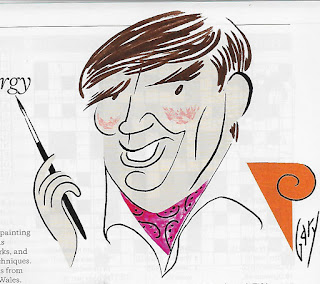It’s been an exhausting few weeks since the last blog, and unlike some I find it difficult to write blogs in the odd cafe, while waiting for the lights to turn green, or when sitting on the back of a Bactrian camel. Anyway, my exhibition of the paintings from the Arctic Light book went well in the superb Osborne Studio Gallery in Belgravia last month. In fact you can still see the catalogue on their website, www.osg.uk.com Although they are of course, paintings of the Arctic, there is a lot you can learn from studying the images for composition, colours, skies, moods, etc.
 I thought you might like to see how the cartoonists see me – here’s a great caricature of me drawn by the excellent caricaturist Gary whose work is regularly featured in the Sunday Times and Daily Mail. This one appeared in The Lady recently when they did a profile on me. Is that a mischievous twinkle in the eyes?
I thought you might like to see how the cartoonists see me – here’s a great caricature of me drawn by the excellent caricaturist Gary whose work is regularly featured in the Sunday Times and Daily Mail. This one appeared in The Lady recently when they did a profile on me. Is that a mischievous twinkle in the eyes?
After the exhibition I ran a course in St Davids and we were blessed with good weather. Although the wind was a bit strong, this really gave us some interesting boisterous seas, with great splashes when the really big waves came crashing in from across the Atlantic. One balmy afternoon on the cliffs in warm and stunning sunlight was truly unforgettable, and perfect for sketching.
I’m delighted to report that my Arctic Light book has just been awarded best outdoor book by the Outdoor Writers’ & Photographers’ Guild, on top of a marvellous batch of reviews. Although it’s not a how-to book it sells well at my demonstrations and workshops, as it’s packed with interesting and at times dramatic compositions and skies, as well as the many tales and sometimes absurd situations that seem to follow me around. I’m told many have put it on their Christmas list. Enjoy your painting!





